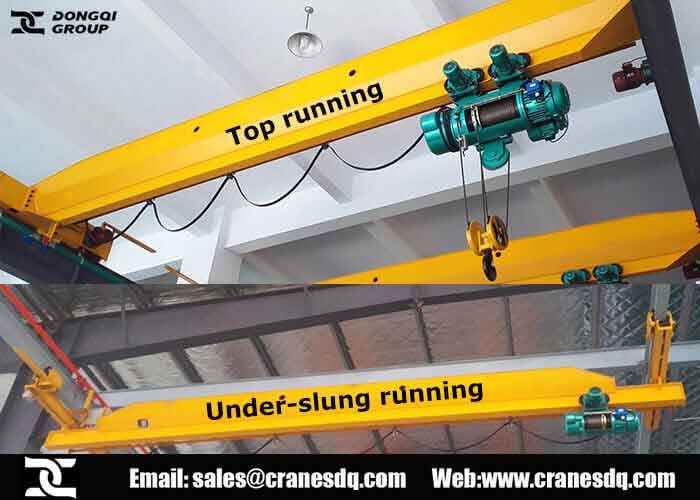Top-Running Vs. Under-Running Overhead Cranes: Differences and Advantages
06 Jan, 2020
As a leading cranes manufacturer and supplier in China, Dongqi has many types of overhead cranes available to serve a specific purpose for a specific operation.
- single girder crane: An overhead traveling crane that utilizes a single bridge beam attached to the two runway/end trucks. This bridge beam or single girder supports a lifting mechanism or hoist that "runs" on the bottom flange of the bridge beam.
- double girder crane: An overhead traveling bridge crane that utilizes two bridge beams set atop the runway (end) trucks. Generally this type of crane utilizes a top running trolley hoist which moves along the top of the two bridge beams on its own set of trucks/trolley wheels. The hook from the hoist "falls" between the two bridge beams. Headroom under the crane is increased by utilizing this hoist/crane configuration.
- top running crane: An electric overhead traveling crane having the end trucks supported on rails attached to the top of the crane runways.
- Under running crane: An electric overhead traveling crane having the end trucks supported on track attached to the bottom flanges of the beam; or supported on bottom flanges of beams. These beams make up the crane runway.
Now we are going to discuss what is the difference between a top-running and a under-hung overhead crane system. You can select what you need, or contact us for more information.

Under running overhead crane:
- Under-hung or under-running cranes are designed for flexibility and functionality, provide an ergonomic design that offers versatility and usability.
- An under-running crane can be suspended directly from the overhead building structure without the need for interfering support columns.
- For an under running system, the end trucks operate on the lower flange of the runway beams, the beams make up the crane runway, much lighter.

The advantages of under-hung cranes:
- A under-running crane can easily operate even in very wide bays, this results in lower equipment costs and lighter design requirements in the building or supporting structure.
- Another advantage to using an under-hung crane system is that multiple under-hung crane runways can be installed adjacent to one another and operate simultaneously.
- And installed under running crane systems is the use of interlock mechanisms and switches, effectively lowering material handling equipment costs.
Top running bridge crane:
- Long bridge spans are more easily achieved with a top-running crane configuration, and in addition, the hook height-the distance from the floor to the hook is greater giving the user much more headroom for lifts.
- A top-running overhead crane has a fixed rail or track system in stalled on the top of each runway beam allowing the end trucks to carry the bridge and hoist along the top of the runway system.
- Top running crane can be configured in a single girder or double girder bridge design. A single girder bridge utilizes an under-hung trolley and hoist, while a double girder most often utilizes a top running trolley hoist.

The advantages of top-running cranes:
- Top running overhead cranes have no limiting capacity meaning that they can be built to handle small capacity loads or large capacity loads, from 1 ton to 100 ton, etc.
- Top running cranes provide added lift height for buildings with limited headroom because they ride on rails on top of the runway beam.
- Top running overhead cranes are typically larger than under running cranes, as they can be built to higher capacities and can accommodate wider spans. And the installation and future maintenance is easier and less time-consuming than an under-hung crane.
How to select a right overhead crane?
- overhead bridge cranes can have many different configurations and the primary options to consider are one or two beams (more often referred to as a single girder or double girder design), freestanding or building supported, and finally, top running vs. under-hung.
- Whether the bridge is top-running or under-hung is dependent on the design of the building structure and the space requirements needed for lift operations.
- You’ll want to give careful consideration to make sure that you understand the requirements of the lifting task and the environment where the crane will be operating to make the right decision of top running or under-hung system.
Here are some of the questions that help us determine the best suit for your needs:
- What is the max load weight you’ll be lifting?
- What materials to be lifting?
- What is the height you'll be lifting? Span?
- Can the existing support structure be utilized or will a freestanding support structure need to be built?
- Are there existing runways in the facility that the crane can be installed on?


